BMW 328is
Coolant System Troubleshooting
Introduction
On Thanksgiving day I took out the machine for the trip to my family's house for dinner. As I started off and the engine came up to temperature, I noticed a smell of antifreeze coming from the main vent. The smell became a bit less pungent as I drove, but it never completely went away. On the way home it did the same thing, except I felt the odor didn't drop as much as it did on the last trip.
The first thought that went through my mind...HEATER CORE. The second thought that went through my mind...$500-800.
Diagnosis
I called my dealer and made an appointment. As always, they took good care of me and arranged for me to have a 2001 525i loaner car for the time it took to complete the repair. I anticipated two days, but it turned into three when we had to do some additional troubleshooting, which went something like this...
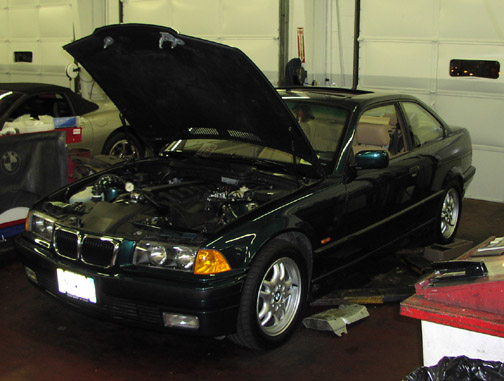
I first spoke to the mechanic (same guy who's been working on my car since I bought it). We chatted a bit about the symtoms and came to agree that I was smelling antifreeze and it was a good possibility that the heater core had a very small leak in it, such that it would leak until the system pressure decreased sufficiently, leaving a small pool of antifreeze in and around the core, then evaporate as the air temperature flowing through the core rose sufficiently.
We attempted to explain the fact that the odor decreased as I drove by the theory that once the small amount of antifreeze had evaporated, the amount of the odor would decrease but would never go away because of the ongoing slow leak. Of course, we were talking only about a few drops of antifreeze in any case, since the interior of my windshield wasn't coated with a film of antifreeze, my carpets weren't wet, and the coolant level had not decreased to any noticeable degree.
When I volunteered my observation that the car needed a top-off of antifreeze every 12000 miles since the car was new, he told me that replacing antifreeze at around that interval is normal in BMWs because (according to the engineers) the system loses coolant via a process of osmosis (coolant slowly seeps through the hoses), and he went on to suggest that a lower level in the coolant bottle wouldn't be a factor unless I had noticed a significant decline in the level recently (and I had not).
Incidentally, while talking about the coolant level sensor in my car, he added an interesting tidbit that E46 drivers might consider interesting...while my E36 has a coolant level sensor that informs me when I need coolant, when BMW extended the oil service intervals to from about 9000 on my car to 15000 on the E46 model, they chose to remove the coolant level sensor so customers wouldn't be alarmed and come in early for their service. How nice of BMW! Not. Attention E46 drivers: check your coolant level every 10K miles or you might be sorry.
So, when all was said and done, the mechanic suggested we order a new heater core now in spite of the fact he hadn't started troubleshooting, because it was the most likely culprit and it might take a couple of days to get the part.
The Culprit
Now, if you know anything about cars, you know that most heater cores (with the exception of some older GM cars from my recollection) are buried under the dash, which makes them VERY difficult to change. Usually, the entire dash must be removed from the car to gain access to them, and, unfortunately, the BMW is no exception.
In fact, BMWs of this vintage are worse in this respect - its dual-zone climate control system makes the heating system even more complex. The heater core is actually two parts fed with independent coolant lines and controlled via independent water control valves. Fortunately, however, everything except the core and its supply lines are accessible from the engine bay. For that reason, the mechanic told me he would start his search for the problem there, and, failing any resolution there, he would dismantle the dash and prepare to replace the core.
On the second afternoon he called to tell me that even after a couple of test runs with the car up to full temperature, he didn't find anything revealing in the engine bay and had dismantled the dash...to find the core in "good condition with no evidence of leaks". He said that when a core fails, it's usually quite obvious, but my core appeared to be in great shape. Ugh. I asked him "Uh, what now?" He then suggested that he would do another pressure test and leave it overnight this time. I took the pictures for this article that night (if you look closely at the first pic, above, you can see the pressure tester connected to the radiator).
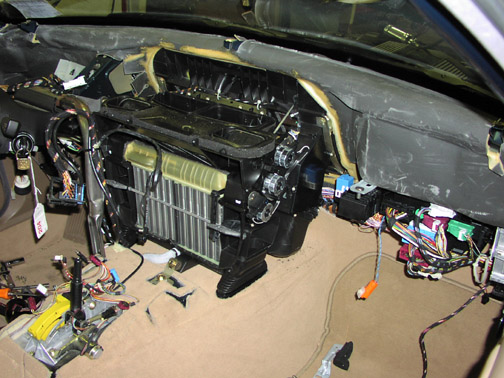
It was at about this point I realized dual-zone heating amounted to needless complexity and that I was glad BMW engineers had chosen to remove that from the E46 and other lines...they have a single-zone system now.
Below is a another view...this time from the driver's seat. You can see that the mechanic removed essentially the entire dash and console. Very scary. Let me tell you...mechanics just don't get enough credit. This was the biggest jigsaw puzzle I'd ever seen.
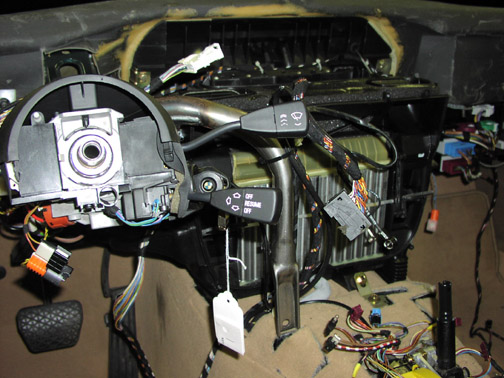
Incidentally, the curved tube just to the right of the steering column is the steering column support and is constructed in a way to prevent the column from collapsing in a collision. The picture doesn't do this thing justice...this is one seriously thick piece of steel and it's welded to nearby structural members EVERYWHERE. There's another one that holds up the passenger airbag and related assemblies, but it's not visible here because most of that side of the dash was in my back seat at this point...
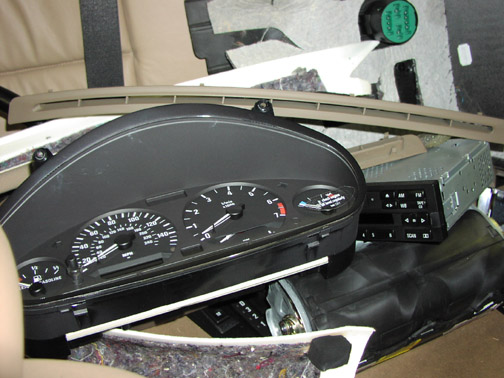
The next morning, when the mechanic called me with the news, I was pleasantly surprised. It turned out NOT to be the heater core! Instead, he said that one of the coolant lines going to the throttle body (which is heated to prevent the formation of ice in the venturi...just like in an aircraft!) was slightly loose and the clamp holding it was defective - it wouldn't tighten anymore. While the engine stayed cool overnight (and thus could not evaporate any leaking coolant) he found a few drips of coolant (hardly a faint stream) leaking off the connection and dropping onto the exhaust manifold...hence the smell.
Below is a picture of the car, all back in one piece. Isn't it interesting how these new paints look totally different when the light hits them from different angles?

And just look at that dash...it looks better than new! Man, my mechanic is a miracle worker!
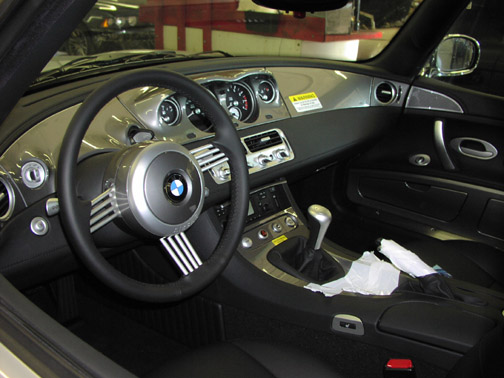
Kidding aside, this $110K beauty was just sitting in the bay next to my baby getting prepped for display. It had arrived a week ago but at this time, had not yet been sold. My sales rep told me the dealer was accepting serious offers, so I pulled a $20 bill out of my pocket. Naturally, everybody standing around me got a good laugh at that one, but I looked at them like I just didn't get it and said "Whhhaaaaaatttt???" I then told my mechanic to watch my car closely that day, since someone might want to steal it. :-)
Needless to say, I didn't even BREATHE on this car when taking these pictures. I'd have to sell my house to pay for a scratch on that aluminum body.
The Damage
I was originally quoted $725 for the heater core swap (the core was $175 of that cost, the remainder labor...and it IS a labor-intensive job, no doubt about it).
However, since they only wound up replacing a $2 clamp and didn't have to physically remove and reinstall the core (more work), the total job was a mere $350. Yes, an expensive troubleshooting process to find a stupid clamp, but sometimes that's just the way life goes. I've said this before, but I'll say it again...owning a BMW ain't cheap.



